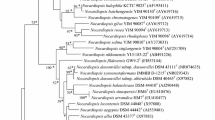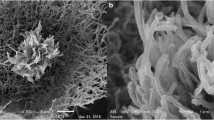Abstract
Two novel Gram-positive, spore-forming, thermophilic actinomycetes, designated as strain YIM 77501T and YIM 77570, were isolated from a sandy soil sample collected at Tengchong National Volcanic Geological Park, Yunnan province, south–west China. Phylogenetic analysis based on the 16S rRNA gene sequences suggested that the two isolates fell within the family Streptosporangiaceae. The strains formed extensively branched substrate and aerial mycelia which carried masses of long, straight or irregular spore chains composed of warty ornamented spores. Cell walls of the two strains contained meso-diaminopimelic acid and glucose, galactose, mannose and ribose were detected as whole-cell sugars. The predominant menaquinones were MK-9(H4) and MK-9(H6). The major polar lipids were diphosphatidylglycerol, phosphatidylethanolamine, N-acetylglucosamine-containing phospholipids and phosphatidylinositol, phosphatidylinositolmannosides. The major cellular fatty acids were iso-C16:0 and 10-methyl C17:0. The DNA G+C content was 74–76 mol%. On the basis of the morphological and chemotaxonomic characteristics as well as the phylogenetic analysis, these strains represents a novel species of a new genus within the family Streptosporangiaceae, for which the name Thermoactinospora rubra gen. nov., sp. nov. is proposed. The type strain of T. rubra is YIM 77501T (=DSM 45614T = CCTCC AA 2011014T).

Similar content being viewed by others
References
Ara I, Kudo T (2007) Sphaerosporangium gen. nov., a new member of the family Streptosporangiaceae, with descriptions of three new species as Sphaerosporangium melleum sp. nov., Sphaerosporangium rubeum sp. nov. and Sphaerosporangium cinnabarinum sp. nov., and transfer of Streptosporangium viridialbum Nonomura and Ohara 1960 to Sphaerosporangium viridialbum comb. nov. Actinomycetologica 21:11–21
Cao YR, Jiang Y, Xu LH, Jiang CL (2009) Sphaerisporangium flaviroseum sp. nov. and Sphaerisporangium album sp. nov., isolated from forest soil in China. Int J Syst Evol Microbiol 59:1679–1684
Chun J, Lee JH, Jung Y, Kim M, Kim S, Kim BK, Lim YW (2007) EzTaxon: a web-based tool for the identification of prokaryotes based on 16S ribosomal RNA gene sequences. Int J Syst Evol Microbiol 57:2259–2261
Collins M, Jones D (1980) Lipids in the classification and identification of Coryneform bacteria containing peptidoglycans based on 2,4-diaminobutyric acid. J Appl Microbiol 48:459–470
Collins M, Pirouz T, Goodfellow M, Minnikin D (1977) Distribution of menaquinones in actinomycetes and corynebacteria. J Gen Microbiol 100:221
Couch JN (1955) A new genus and family of the actinomycetales, with a revision of the genus Actinoplanes. J Elisha Mitchell Sci Soc 71:148–155
Felsenstein J (1981) Evolutionary trees from DNA sequences: a maximum likelihood approach. J Mol Evol 17:368–376
Felsenstein J (1985) Confidence limits on phylogenies: an approach using the bootstrap. Evolution 39:783–791
Felsenstein J (2002) PHYLIP (phylogeny inference package), version 3.6a. Department of Genome Science, University of Washington, Seattle
Fitch WM (1971) Toward defining the course of evolution: minimum change for a specific tree topology. Syst Biol 20:406
Gonzalez C, Gutierrez C, Ramirez C (1978) Halobacterium vallismortis sp. nov. An amylolytic and carbohydrate-metabolizing, extremely halophilic bacterium. Can J Microbiol 24:710–715
Goodfellow M, Stanton L, Simpson K, Minnikin D (1990) Numerical and chemical classification of Actinoplanes and some related actinomycetes. J Gen Microbiol 136:19
Goodfellow M, Maldonado LA, Quintana ET (2005) Reclassification of Nonomuraea flexuosa (Meyer 1989) Zhang et al. 1998 as Thermopolyspora flexuosa gen. nov., comb. nov., nom. rev. Int J Syst Evol Microbiol 55:1979–1983
Groth I, Schumann P, Rainey F, Martin K, Schuetze B, Augsten K (1997) Demetria terragena gen. nov., sp. nov., a new genus of actinomycetes isolated from compost soil. Int J Syst Bacteriol 47:1129–1133
Hasegawa T, Takizawa M, Tanida S (1983) A rapid analysis for chemical grouping of aerobic actinomycetes. J Gen Appl Microbiol 29:319–322
Hayakawa M, Nonomura H (1987) Humic acid-vitamin agar, a new medium for the selective isolation of soil actinomycetes. J Ferment Technol 65:501–509
Huß V, Festl H, Schleifer K (1983) Studies on the spectrophotometric determination of DNA hybridization from renaturation rates. Syst Appl Microbiol 4:184–192
Jahnke KD (1992) BASIC computer program for evaluation of spectroscopic DNA renaturation data from Gilford System 2600 spectrophotometer on a PC/XT/AT type personal computer. J Microbiol Methods 15:61–73
Kelly K (1964) Inter-Society Color Council—National Bureau of Standards color name charts illustrated with centroid colors. US Government Printing Office, Washington DC
Kimura M (1980) A simple method for estimating evolutionary rates of base substitutions through comparative studies of nucleotide sequences. J Mol Evol 16:111–120
Kroppenstedt RM (1985) Fatty acid and menaquinone analysis of actinomycetes and related organisms. In: Goodfellow M, Minnikin DE (eds) Chemical methods in bacterial systematics. Academic Press, London, pp 173–199
Kudo T, Itoh T, Miyadoh S, Shomura T, Seino A (1993) Herbidospora gen. nov., a new genus of the family Streptosporangiaceae Goodfellow et al. 1990. Int J Syst Bacteriol 43:319–328
Lechevalier H, Lechevalier MP (1970a) A critical evaluation of the genera of aerobic actinomycetes. In: Prauser H (ed) The actinomycetales, Jena, VEB Gustav Fischer, pp 393–405
Lechevalier MP, Lechevalier H (1970b) Chemical composition as a criterion in the classification of aerobic actinomycetes. Int J Syst Bacteriol 20:435–443
Lechevalier MP, De Bievre C, Lechevalier H (1977) Chemotaxonomy of aerobic actinomycetes: phospholipid composition. Biochem Syst Ecol 5:249–260
Ley JD, Cattoir H, Reynaerts A (1970) The quantitative measurement of DNA hybridization from renaturation rates. Eur J Biochem 12:133–142
Li WJ, Xu P, Schumann P, Zhang YQ, Pukall R, Xu LH, Stackebrandt E, Jiang CL (2007) Georgenia ruanii sp. nov., a novel actinobacterium isolated from forest soil in Yunnan (China), and emended description of the genus Georgenia. Int J Syst Evol Microbiol 57:1424–1428
Mesbah M, Premachandran U, Whitman WB (1989) Precise measurement of the G+C content of deoxyribonucleic acid by high-performance liquid chromatography. Int J Syst Bacteriol 39:159–167
Meyer J (1989) Genus Actinomadura Lechevalier and Lechevalier 1970a, 400 AL. Bergey’s Man Syst Bacteriol 4:2511–2526
Minnikin D, Collins M, Goodfellow M (1979) Fatty acid and polar lipid composition in the classification of Cellulomonas, Oerskovia and related taxa. J Appl Microbiol 47:87–95
Runmao H, Guizhen W, Junying L (1993) A new genus of actinomycetes, Planotetraspora gen. nov. Int J Syst Bacteriol 43:468–470
Saitou N, Nei M (1987) The neighbor-joining method: a new method for reconstructing phylogenetic trees. Mol Biol Evol 4:406–425
Shirling EB, Gottlieb D (1966) Methods for characterization of Streptomyces species. Int J Syst Bacteriol 16:313–340
Stackebrandt E, Rainey FA, Ward-Rainey NL (1997) Proposal for a new hierarchic classification system, Actinobacteria classis nov. Int J Syst Bacteriol 47:479–491
Tamura T, Suzuki S, Hatano K (2000) Acrocarpospora gen. nov., a new genus of the order Actinomycetales. Int J Syst Evol Microbiol 50:1163–1171
Tamura K, Dudley J, Nei M, Kumar S (2007) MEGA4: molecular evolutionary genetics analysis (MEGA) software version 4.0. Mol Biol Evol 24:1596–1599
Tang SK, Wang Y, Chen Y, Lou K, Cao LL, Xu LH, Li WJ (2009) Zhihengliuella alba sp. nov., and emended description of the genus Zhihengliuella. Int J Syst Evol Microbiol 59:2025–2032
Thiemann J, Beretta G (1968) A new genus of the Actinoplanaceae: Planobispora, gen. nov. Arch Microbiol 62:157–166
Thiemann J, Pagani H, Beretta G (1967) A new genus of the Actinoplanaceae: Planomonospora, gen. nov. Giorn Microbiol 15:27–38
Thompson JD, Gibson TJ, Plewniak F, Jeanmougin F, Higgins DG (1997) The CLUSTAL_X windows interface: flexible strategies for multiple sequence alignment aided by quality analysis tools. Nucleic Acids Res 25:4876–4882
Waksman SA (1961) The Actinomycetes. Classification, identification and description of genera and species, vol 2. The Williams and Wilkins Co., Baltimore
Xu P, Li WJ, Tang SK, Zhang YQ, Chen GZ, Chen HH, Xu LH, Jiang CL (2005) Naxibacter alkalitolerans gen. nov., sp. nov., a novel member of the family ‘Oxalobacteraceae’ isolated from China. Int J Syst Evol Microbiol 55:1149–1153
Zhang Z, Wang Y, Ruan J (1998) Reclassification of Thermomonospora and Microtetraspora. Int J Syst Bacteriol 48:411–422
Zhi XY, Li WJ, Stackebrandt E (2009) An update of the structure and 16S rRNA gene sequence-based definition of higher ranks of the class Actinobacteria, with the proposal of two new suborders and four new families and emended descriptions of the existing higher taxa. Int J Syst Evol Microbiol 59:589–608
Zhou ZH, Liu ZH, Qian YD, Kim SB, Goodfellow M (1998) Saccharopolyspora spinosporotrichia sp. nov., a novel actinomycete from soil. Int J Syst Bacteriol 48:53–58
Acknowledgments
This research was supported by the National Natural Science Foundation of China (No. 31070007) and International Cooperation Research Program of Yunnan Province (No. 2009AC017). Special thanks should be given to the entire staff from Tengchong National Volcanic Geological Park for their help and support during the field sampling.
Author information
Authors and Affiliations
Corresponding author
Electronic supplementary material
Below is the link to the electronic supplementary material.
Rights and permissions
About this article
Cite this article
Zhou, EM., Tang, SK., Sjøholm, C. et al. Thermoactinospora rubra gen. nov., sp. nov., a thermophilic actinomycete isolated from Tengchong, Yunnan province, south–west China. Antonie van Leeuwenhoek 102, 177–185 (2012). https://doi.org/10.1007/s10482-012-9725-z
Received:
Accepted:
Published:
Issue Date:
DOI: https://doi.org/10.1007/s10482-012-9725-z




